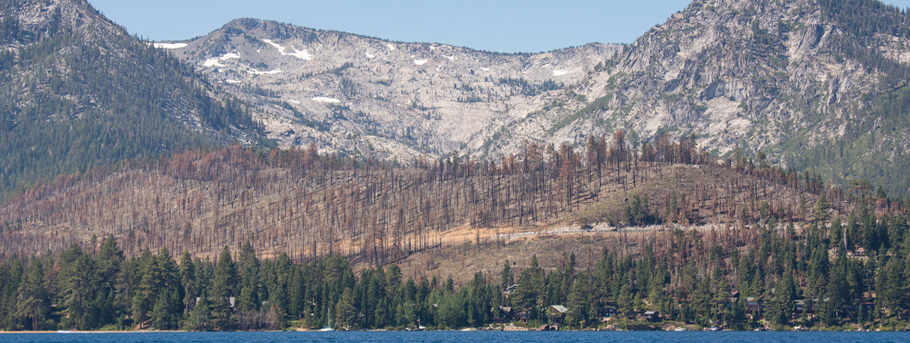By Joanne S. Marchetta
When it comes to weather, normal has become an elusive term. On the ground here in Tahoe, it feels like the only things that can pierce our prolonged drought are occasional debilitating storms. Trees weakened by drought can falter under layers of ice and snow from wet storms, causing widespread power and communication outages that can last for days. Meanwhile, “surreal” winter wildfires near Big Sur and Laguna Beach remind us that fire seasons don’t really end anymore.
The Lake Tahoe Region is being whipsawed by a confluence of climate impacts. Just as these impacts weave throughout our environment and communities, how we as a region take action to confront these new threats must cross all divides. The Tahoe Regional Planning Agency (TRPA) is organizing basin partners on multiple fronts including transportation, workforce housing, aquatic invasive species, forest health, and others to build climate adaptations into every sector.
With last summer’s fires still fresh in our minds, bringing climate resilience to Lake Tahoe’s forests is a top priority. Heavily overstocked and untreated forest stands are a wick waiting for a match. TRPA is advancing a key policy change this month aimed at helping fire managers increase the pace and scale of forest fuel reduction projects. To scale up to whole-forest treatment strategies, partners are implementing projects over much larger areas, such as the 59,000-acre Lake Tahoe West forest resilience project. Project managers need a full range of tools to work efficiently over varied and sometimes sensitive terrain.
Fuel reduction work on steep slopes is often infeasible without ground-based mechanical equipment. Multiple basin policies have limited work on hillslopes with a 30-50 percent gradient to hand crews in order to minimize erosion to the watershed. However, approximately 60,000 untreated acres in the Tahoe Basin are sloped at 30-50 percent, and 41 percent of those acres are within wildland urban interface zones where forest thinning and maintenance are needed to protect neighborhoods.
As a founding member of the Tahoe Fire and Fuels Team, TRPA worked with scientists from the USDA Forest Service and the University of Idaho to draft science-based policy changes that will maintain environmental protections while allowing for increased use of low-impact ground-based mechanical equipment on slopes between 30 and 50 percent. Next week, we will bring the proposed amendments to the TRPA Governing Board for consideration. If approved, this will be a capstone to the streamlining improvements TRPA and other agencies have pursued to make our forests fire resilient since the 2007 Angora Fire.
Lessons learned from Angora have led us to rethink how we prepare the landscape for the inevitable fires of the future. Policy updates, greater coordination among fire agency partners, and better homeowner engagement and readiness are all helping prepare Tahoe for increasingly intense wildfires. As the Caldor Fire showed us, those preparations matter. Following recommendations from the Bi-State Fire Commission, TRPA has also worked collaboratively to increase funding and expedite forest health and fuel reduction project planning and implementation. The commission’s recommendations have been our roadmap, and while the major work is nearing completion, adapting the Lake Tahoe Region to climate change will require all of us to search for new strategies and to maintain momentum. TRPA will not be paralyzed or daunted by the need for change. I hope you will join us and support this important work.
Our gratitude goes out to the prescribed fire crews who are adapting and taking advantage of our fickle winter by returning healthy fire to Lake Tahoe’s ecosystem. On still mornings, you may see smoke columns rising as these crews rid the basin of thousands of wood piles left behind from hand thinning. Their work is evidence that climate adaptions can protect our communities and increase the resilience of our forests. You can stay up to date on prescribed fire operations and more by visiting tahoelivingwithfire.com.
–Joanne S. Marchetta is the Executive Director of the Tahoe Regional Planning Agency

